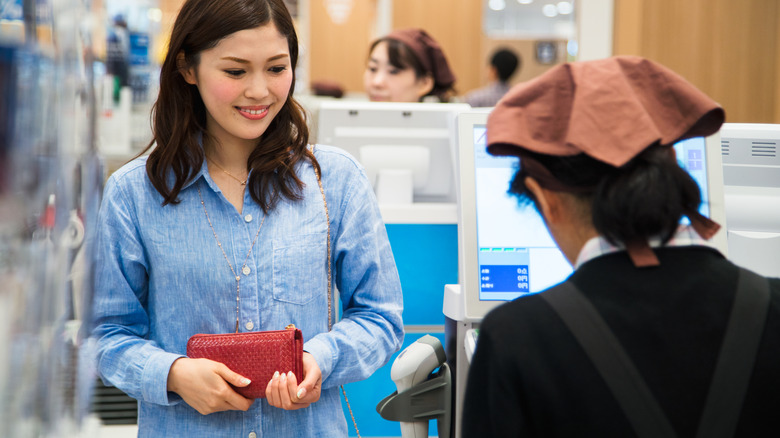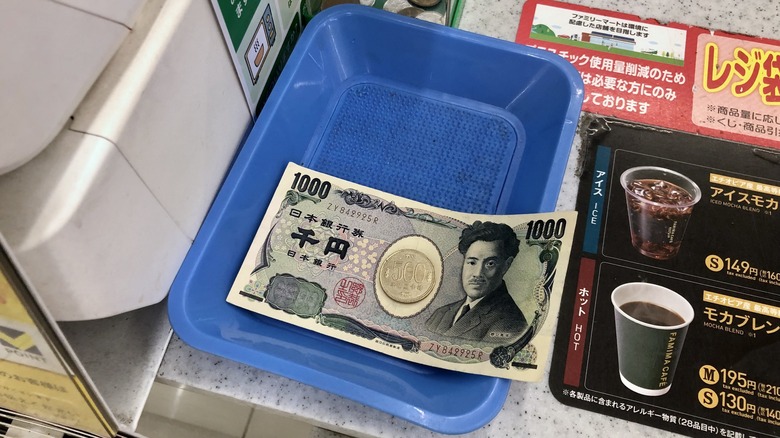This Common Way To Handle Money In America Is Seen As Unusual In Japan
When you visit Japan, the simple act of handing a cashier money could lead to an awkward moment. An American tourist might think nothing of that gesture since it's a common one to make when paying for something in the U.S. In Japan, however, you may find that the cashier seems hesitant to accept money from your hand, motioning instead for you to place it in a change tray.
These trays are usually right next to the cash register. Sometimes, they're even built into the side of it. They're there as a receptacle for every customer's money, so don't mistake it as a sign of germophobia or xenophobia on the cashier's part. It's not that anyone means to shun you personally, avoiding your hand like it's radioactive. If you're standing in line, you might see the person ahead of you putting their coins and bills in the tray. The cashier will then scoop up the money (or the tray itself, if it's moveable) before returning the customer's change to it with a receipt.
When it's your first time encountering this cultural practice, and you've already extended your hand with money, it might seem silly to have to set it down in the tray and wait for the cashier to pick it up. That's just how it's done, though, as a matter of long-held custom. In the same way that handshakes are a common greeting to avoid in Japan, you won't normally make physical contact with a cashier when you pay.
How and why trays came between hands
Above, you can see a change tray on the checkout counter at Family Mart, one of Japan's biggest convenience store chains. This is the standard, plastic type of change tray, or tsurisen torei, in Japanese. There are other terms for it, such as karuton or koin torei, which just sound like the English words, "carton" and "coin tray," transcribed into Japanese.
In some restaurants and shops, you'll see nicer, leather or wooden versions of these trays. According to The Japan Times, they've been in use for over a century, with a dictionary of new words logging one reference to them in 1918. At the tail end of the Edo Period, 50 years before that, most merchants were still letting customers run up tabs, to be settled twice annually. The advent of cash sales in Japan's first department store, Mitsukoshi (which opened its main branch in Nihonbashi, Tokyo, in 1914), may have helped turn the tide in favor of change trays.
There are various theories why the tray trend stuck and became tradition. Some claim it's a simple sanitary measure. Others see it as a way to maintain personal space or let customers count out their money and confirm they haven't been shortchanged. One shopkeeper told the Times, "Japanese prefer not to touch other people's hands and the tray creates desirable distance. So you could say that using a tray is an expression of reserve as well as an extension of good customer service."
From change trays to semi-self-checkout
In the 2020s, methods for handling cash have continued to evolve in Japan, thanks in part to the pandemic. As stores started putting up plastic sheets between customers and cashiers, they also began pivoting to contactless forms of payment. At my local supermarket, OK Store, in Chofu, Tokyo, the checkout clerks now scan your purchases, but they no longer handle your money (so they're not technically "cashiers" anymore). Instead, when you get to the payment step, the clerks route you to a touchscreen, where you do a kind of supervised self-checkout, feeding the money into the machine yourself. This eliminates both the need for conventional change trays and the possibility of human error during the transaction process.
Coffee lovers might gravitate to Japan's 7-Elevens, where a similar "semi-self-checkout" system is now in place at most stores. Here again, trays have given way to change dispensers, where the register spits out your change like a vending machine would. The clerk never touches it. In 2025, the same chain is preparing to go full self-checkout with its registers so that customers do their own price scanning, too.
In the near future, your fingers might not even have to make contact with a touchscreen, as 7-Eleven Japan has also made headlines for testing out futuristic, floating hologram self-checkouts in select locations. Even if you never encounter that in your travels here, it helps to know that handing a cashier money is something tourists should never do when visiting Japan.


